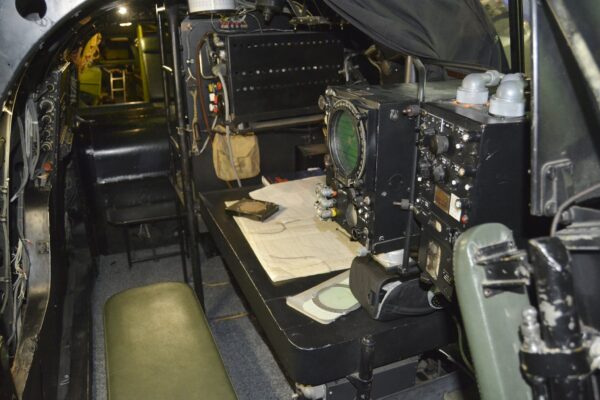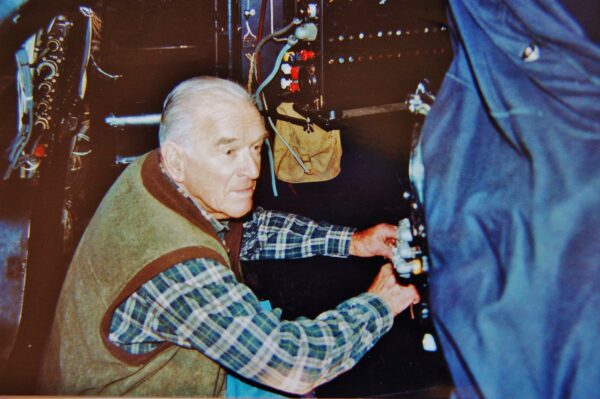Stories
Stories
To Berlin in a Big Wind
Having survived a very dodgy first op – they lost an engine, an incendiary bombs lodged in the wing and on landing the undercarriage collapsed – Des Andrewes, the Navigator for Chuck Struthers’ crew of 622 Squadron was thrown in the deep end on what became known as “The Night of the Big Winds”.

Desmond Yarborough Andrewes NZ427174
Their Lancaster III (GI-M ED619) of 622 Squadron, left Mildenhall on 24 March on their 4th operation. Berlin was the target.
Des takes up the story in Kiwis Do Fly: “All of our plotting that night was based on the met forecast winds of around 35 knots. We seemed to keep in the bomber stream out over the North Sea then headed into the Baltic with a planned landfall over Denmark”.
“Our gunners saw flak over to starboard and it seemed a bit heavy for a coastal fishing village. I hadn’t twigged our drift was probably taking us nearer Rostock. As the broadcast update of wind speeds increased so at our level of 20,000 feet, I made an allowance for 20 knots”.
The planned route called for a final timed 60 minute mile leg to Berlin but before Dec could give the pilot this heading, the Bomb Aimer sung out, “There’s a lake and a park ahead. It looks just like the briefing photo of Havelsee in Berlin”.
After his first op, when their bomber was 35 miles out on their coast landfall, the Squadron Navigation Officer hadn’t been impressed. Des recalled that the Commanding Officer had recommended that to finish their tour they had better stay nearer the mainstream. Des now thought, “I’ve mucked it up again, back to OTU you for me!”

The nav station with H2S screen and curtain pulled back. The pilot seats armour (top right) protects the equipment but not the operator.
(Credit: NZBCA Archives)
The crew quickly realised that they must be one of the first bomber over Berlin that night as everything was quiet. “No flak and no markers, so I called up the skipper and suggested we head due East to orbit for a while. The crew were not impressed!”
The gunners were told to watch for the target markers “And as soon as they went off, so would we”. Des’ diary records their bombing run at a heading of 060o while the main force had 200 o as their run in.
“We got a good photo flash but it was two days later when the photo interpretation bods could locate precisely where we had bombed, just six miles off target!”
Once they had left Berlin Des started a new air plot still using the updated wind data being broadcast for Osnabruk, so they would avid the Ruhr. His skipper, Chuck, kept asking for headings as he could see a big flak belt up ahead. “I still couldn’t work out what the hell was happening. Anyway I gave a series of courses that took us up around the top of the of ‘Happy Valley’ (The Ruhr) and then out”.
The first Gee fix plus 45 miles south of track. “Oh no not again it’s back to OUT for sure and a new crew for certain”, thought Des
Once we landed the skipper asked me what really went wrong? I didn’t know!
Des and his crew picked up the perimeter bus to go for debriefing and at the next stop the Pilot and Navigator of that Lancaster were having a heated argument about fixes. This Navigator slumped into the bus next to Des Andrews, very upset. “We didn’t even get there”, he said. At this Des was really pleased – he wouldn’t be the only one reporting to the Navigation Leader next day.
But at the briefing Des and the crew were congratulated for finding the target in 85 knot winds. “Apparently the Met Flight boys didn’t believe their measurements so knocked up a few knots off”. The wind speeds they reported were still not believed by the met Flight Office either so they knocked quite a few more off”.
The next morning Des was amused to listen to the BBC announcing another night of successful Bomber Command raids on Berlin, Leipzig, Hanover and numerous targets in the Ruhr!
Some days later the Navigators ran a plot on position and found some aircraft encountered 138 knot winds. “ We had never heard of jet streams (or even jets), but we never got into so much trouble again once the ground mapping H2S sets came into use”.
Des and his crew kept lucky, completing a full tour of 30 operations with 282 hours on night operations from 15/3/44 Stuttgart to 18/7/44- Aulnooye in the crew of F/O H.C Struthers.
Des told the story that his Aussie skipper , Chook Struthers once called him up to look at the fires and flak over Berlin , once they had finished their bombing run. “Gawd strewth”, said Des. “I had never seen anything like it and was very pleased to go back to my desk , pull the curtain and return to my world. I never went up front again.”
Des Andrewes was one of the original veterans who helped restore the Lancaster at MOTAT and was one of the last of the Wednesday Boys.

Des at the Navigator’s table in MOTAT’s Lancaster